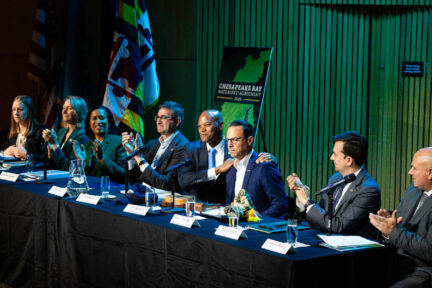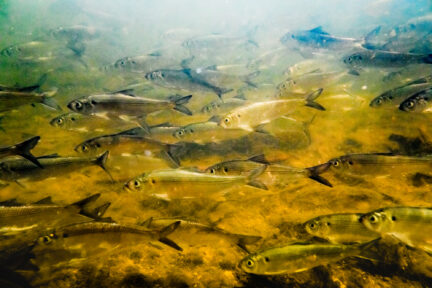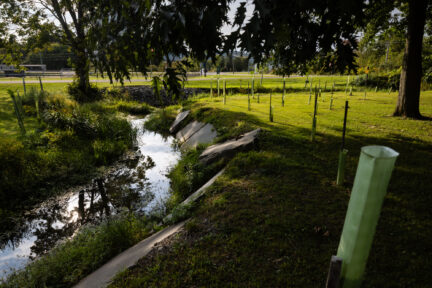Chesapeake Bay Program welcomes feedback on Conowingo Watershed Implementation Plan
Chesapeake Bay Program welcomes feedback on Conowingo Watershed Implementation Plan
The Chesapeake Bay Program is soliciting public input on the draft Conowingo Watershed Implementation Plan (WIP). The Conowingo WIP was developed collaboratively by a steering committee consisting of representatives from the Chesapeake Bay Commission and each Chesapeake Bay watershed jurisdiction—Delaware, the District of Columbia, Maryland, New York, Pennsylvania, Virginia and West Virginia—and supported by the Center for Watershed Protection and the Environmental Protection Agency (EPA).
WIPs are detailed strategies that outline actions to be taken to reduce nitrogen, phosphorus and sediment pollutants flowing into the Chesapeake Bay. Each watershed jurisdiction has developed their own WIP detailing how they plan to meet their pollutant reduction targets under the Chesapeake Bay Total Maximum Daily Load (Bay TMDL).
In September 2019, the EPA announced it had awarded nearly $600,000 for three projects to further the Conowingo WIP, including support for overseeing its development and implementation to the Center for Watershed Protection. Each watershed jurisdiction contributed a portion of their EPA Chesapeake Bay grant funding to the award.
The Conowingo WIP identifies actions to be taken by each of the watershed jurisdictions to reduce the additional nitrogen and phosphorus pollution resulting from the inability of the reservoir behind the dam to trap nutrients from flowing downstream into the Bay. The WIP is the first phase in this effort and will be followed by a detailed financing strategy.
The Chesapeake Bay Program values input from all stakeholders, including individual residents, businesses, watershed groups and local governments. Comments on the draft WIP are welcomed between Wednesday, October 14, 2020 and Wednesday, January 20, 2020. Feedback will help the Chesapeake Bay Program better evaluate the feasibility, costs and approach of the WIP, while informing the future financing strategy and implementation of the plan.
Interested parties can offer input by submitting comments to the Center for Watershed Protection at CWIP@chesapeakebay.net. Any questions related to the draft WIP may also be directed to this email address. A webinar that provides additional information about the draft Conowingo WIP may be accessed at https://www.chesapeakebay.net/who/group/conowingo_watershed_implementation_plan_steering_committee.
Facts
Every day, approximately 25 billion gallons of freshwater flow from the Susquehanna River into the Chesapeake Bay, passing through the Conowingo Dam along its way. In fact, the Susquehanna alone provides 50% of the Bay’s freshwater supply. A reservoir located behind the Conowingo Dam has trapped an average of three-and-a-half million pounds of phosphorus and four billion pounds of sediment every year since the dam opened in 1928. This is approximately a third of the phosphorus and half of the sediment that flows into the Chesapeake Bay annually.
When the Bay TMDL was put into place in 2010, it assumed that the reservoir would continue trapping nutrients and sediment as it always had.
Issues
In 2015, a U.S. Geological Survey report estimated that the reservoir behind the dam had reached 92% of its capacity to trap nutrients and sediment. Additionally, another report by the Lower Susquehanna River Watershed Assessment team confirmed that since the reservoir is essentially full, it is trapping smaller amounts of incoming sediment and sending more and more of it, along with the nutrients that attach to it, over the dam and downstream into the Chesapeake Bay. While sediment is detrimental enough in reducing water clarity and dissolved oxygen in the Bay, it also can carry chemical contaminants such as pesticides and polychlorinated biphenyls (PCBs) in addition to nutrients. All these factors harm water quality and the living resources in the Bay.
Importance
The draft Conowingo WIP is an example of the collaborative nature of the Chesapeake Bay Program and the desire to explore innovations that will reduce implementation costs and accelerate achievement of our restoration goals. In early 2018, the partnership’s Principals’ Staff Committee decided that a steering committee made up of representatives from each watershed jurisdiction and the Chesapeake Bay Commission would oversee development of the WIP, with support from the EPA and the grantees.
The Conowingo WIP is separate from the WIPs developed by the Chesapeake Bay watershed jurisdictions in order to meet their pollutant reduction targets under the Bay TMDL. It is intended to address the additional pollutant loads, estimated to be approximately six million pounds of nitrogen and 0.26 million pounds of phosphorus, resulting from the inability of the reservoir behind the Conowingo Dam to continue trap nutrient and sediment pollution.
Quotes
“It’s been a privilege to work with my Bay colleagues across jurisdictions on this exciting and innovative approach to achieving our pollutant reduction goals. Importantly, we now get to hear from other stakeholders and practitioners implementing projects on the ground how the WIP can work with their existing plans, commitments and funding programs. This process will provide a critical reality check on the plan and help guide it’s future.”
- Matt Rowe, Co-Chair of the Conowingo WIP Steering Committee and Assistant Director, Water and Science Administration, Department of the Environment, State of Maryland
"Pennsylvania is pleased to collaborate with our regional partners on developing the Conowingo WIP. From our state WIP process, we know the value of thoughtful grassroots review of proposed strategies for the watershed. We encourage the many partners who are working toward a healthier watershed to share their views on these strategies for additional nutrient reductions in relation to the dam."
- Jill Whitcomb, Co-Chair of the Conowingo WIP Steering Committee and Director, Chesapeake Bay Program Office, Department of Environmental Protection, Commonwealth of Pennsylvania
“The Conowingo WIP is a little different from the others in that it has one focus: nitrogen. The goal of the plan is to find the lowest cost solutions to eliminate six million pounds of nitrogen pollution entering waterways. The Conowingo WIP is a much-needed solution to a challenging problem that will build on, but not duplicate, the WIPs that jurisdictions are already using to meet their existing goals.”
- Bryan Seipp, Watershed Planner, Center for Watershed Protection



